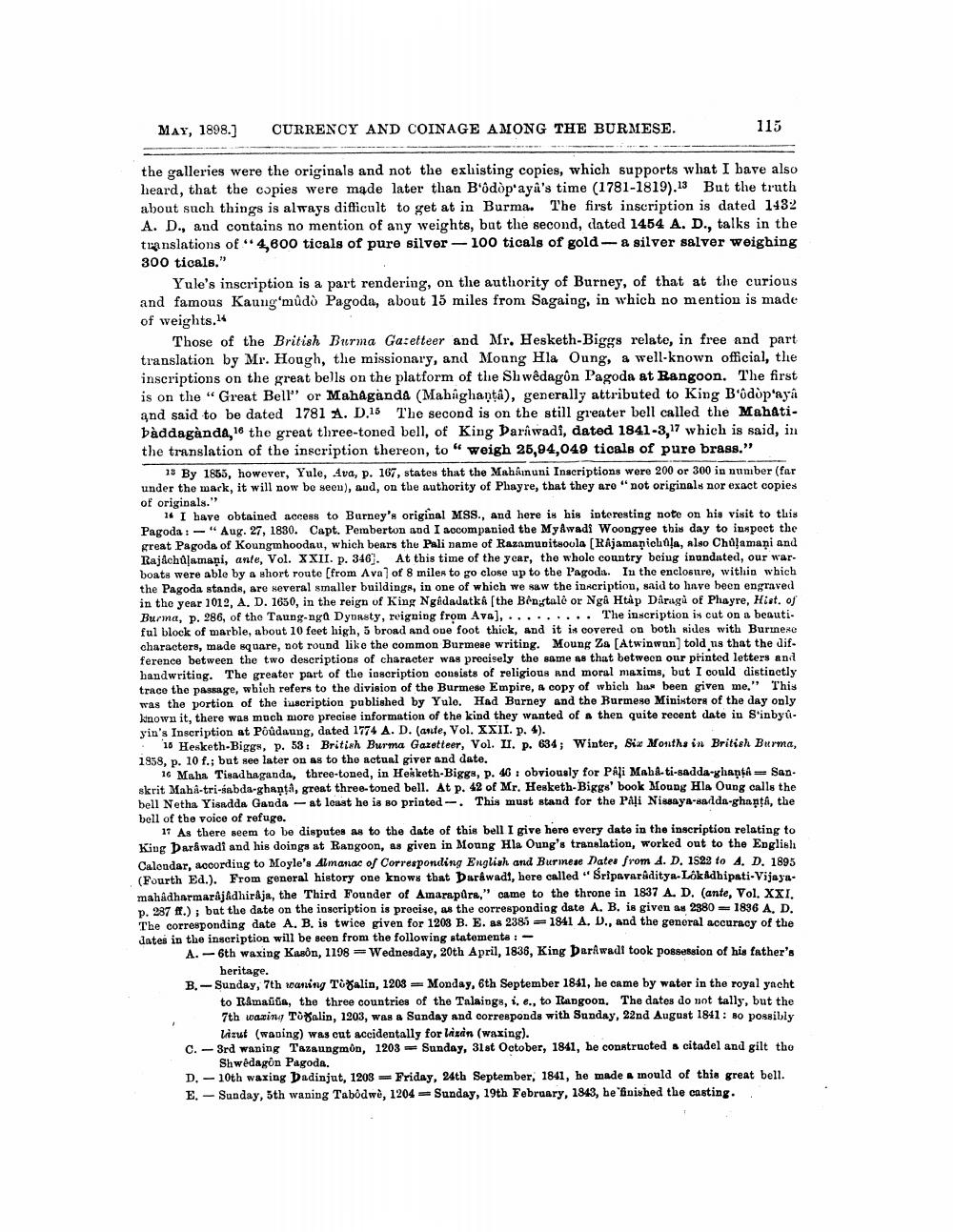________________
MAY, 1898.]
CURRENCY AND COINAGE AMONG THE BURMESE.
115
the galleries were the originals and not the exhisting copies, which supports what I have also heard, that the copies were made later than Bodop'aya's time (1781-1819).13 But the truth about such things is always difficult to get at in Burma. The first inscription is dated 1432 A. D., and contains no mention of any weights, but the second, dated 1454 A. D., talks in the translations of "4,600 ticals of pure silver - 100 ticals of gold- & silver salver weighing 300 ticals."
Yule's inscription is a part rendering, on the authority of Burney, of that at the curious and famous Kaung'můdo Pagoda, about 15 miles from Sagaing, in which no mention is made of weights.
Those of the British Burma Ga:etteer and Mr. Hesketh-Biggs relate, in free and part translation by Mr. Hough, the missionary, and Moung Hla Oung, a well-known official, the inscriptions on the great bells on the platform of the Shwedagûn Pagoda at Rangoon. The first is on the “Great Bell" or Mahaganda (Mabighanta), generally attributed to King B'odòp'aya and said to be dated 1781 A. D.15 The second is on the still greater bell called the Mahatibàddagànda, 16 the great three-toned bell, of King Darawadi, dated 1841-3,17 which is said, in the translation of the inscription thereon, to "weigh 25,94,049 ticals of pure brass."
13 By 1855, however, Yule, Ava, p. 167, states that the Mahanuni Inscriptions were 200 or 300 in number (far under the mack, it will now be secu), aud, on the authority of Phayre, that they aro "not originals nor exact copies of originals."
14 I have obtained access to Burney's original MSS., and here is his interesting note on his visit to this Pagoda : "Aug. 27, 1830. Capt. Pemberton and I accompanied the My Awadi Woongyee this day to inspect the great Pagoda of Koungmhoodnu, which bears the Pali name of Razamuditeoola (RAjamapiolla, also Chamani and Rajachalamaņi, ante, Vol. XXII. p. 346). At this time of the year, tho whole country being inundated, our warboats were able by a short route (from Aval of 8 miles to go close up to the Pagoda. In the enclosure, within which the Pagoda stande, are several smaller buildings, in one of which we saw the inscription, said to hnve been engraved in the year 2012, A.D. 1650, in the reign of King Ngadadatka (the Bengtalo or Ngå Håp Darugů of Phayre, Hist. of Burma, p. 286, of the Taung.ng Dynasty, reigning from Ava), ......... The inscription is cut on a beauti. ful block of marble, about 10 eet high, 5 broad and one foot thick, and it is covered on both sides with Burnere characters, made square, not round like the common Burmese writing. Moung Za [Atwinwan) told na that the difference between the two descriptions of character was precisely the same as that betweon our printed letters and handwriting. The greater part of the inscription consists of religious and moral maxime, but I could distinctly trace the passage, wbich refers to the division of the Burmese Empire, A copy of which has been given me." This was the portion of the inscription published by Yule. Had Burney and the Burmese Ministers of the day only known it, there was much more precise information of the kind they wanted of a then quite recent date in S'inbyů. yin's Inscription at Poúdaung, dated 1774 A. D. (ante, Vol. XXII. p. 4). • 10 Hesketh-Biggs, p. 53: British Burma Gazetteer, Vol. II, p. 634; Winter, Sia Months in British Burma, 1958, p. 10 f.; but see later on as to the actual giver and date.
16 Maha Tisadhaganda, three-toned, in Hesketh-Biggs, p. 46 obviously for PAli Maba-ti-sadda-hapa-San. skrit Mahi-tri-sabda-ghanţa, great three-toned bell. At p. 42 of Mr. Hesketh-Biggs' book Moung Hla Oung calls the bell Netha Yisadda Ganda - at least he is so printed . This must stand for the Påļi Nissaya-salda-ghapta, the bell of the voice of refuge.
11 As there seem to be disputes as to the date of this bell I give here every date in the inscription relating to King Darwadi and his doings at Rangoon, as given in Moung Hla Oung's translation, worked out to the English Calondar, according to Moyle's Almanac of Corresponding English and Burmese Dates from d. D. 1522 to 4. D. 1895 (Fourth Ed.). From general history one knows that Darwadi, here called "Srlpovaraditya.Lok Adhipati-Vijayamahadharmaraj Adhiraja, the Third Founder of Amarapura," came to the throne in 1837 A. D. (ante, Vol. XXI. P. 287 m.); but the date on the inscription is procise, as the corresponding date A, B, is given as 2380 - 1896 A. D. The corresponding date A. B. is twice given for 1203 B. E. as 2385 = 1841 A, D., and the general accuracy of the dates in the inscription will be seen from the following statemente: -
A.-6th waxing Kaan, 1108 Wednesday, 20th April, 1836, King Dar wadi took possession of his father's
heritage. B.-Sunday, 7th waning Tofalin, 1203 Monday, 6th September 1841, he came by water in the royal yacht
to Ramata, the three countries of the Talaings, i, e., to Rangoon, The dates do not tally, but the 7th waxin, ToXalin, 1203, was a Sunday and corresponds with Sunday, 22nd August 1841 : 80 possibly
lazut (waping) was cut accidentally for lazan (waxing). c.3rd waning Taxaungmon, 1203 Sunday, 31st October, 1841, he constructed a citadel and gilt tho | Shwedagon Pagoda. D.-10th waxing Dadinjut, 1203 Friday, 24th September, 1841, he made a mould of this great bell. E. - Sunday, 5th waning Tabòdwe, 1204 Sunday, 19th February, 1843, be buished the casting.




